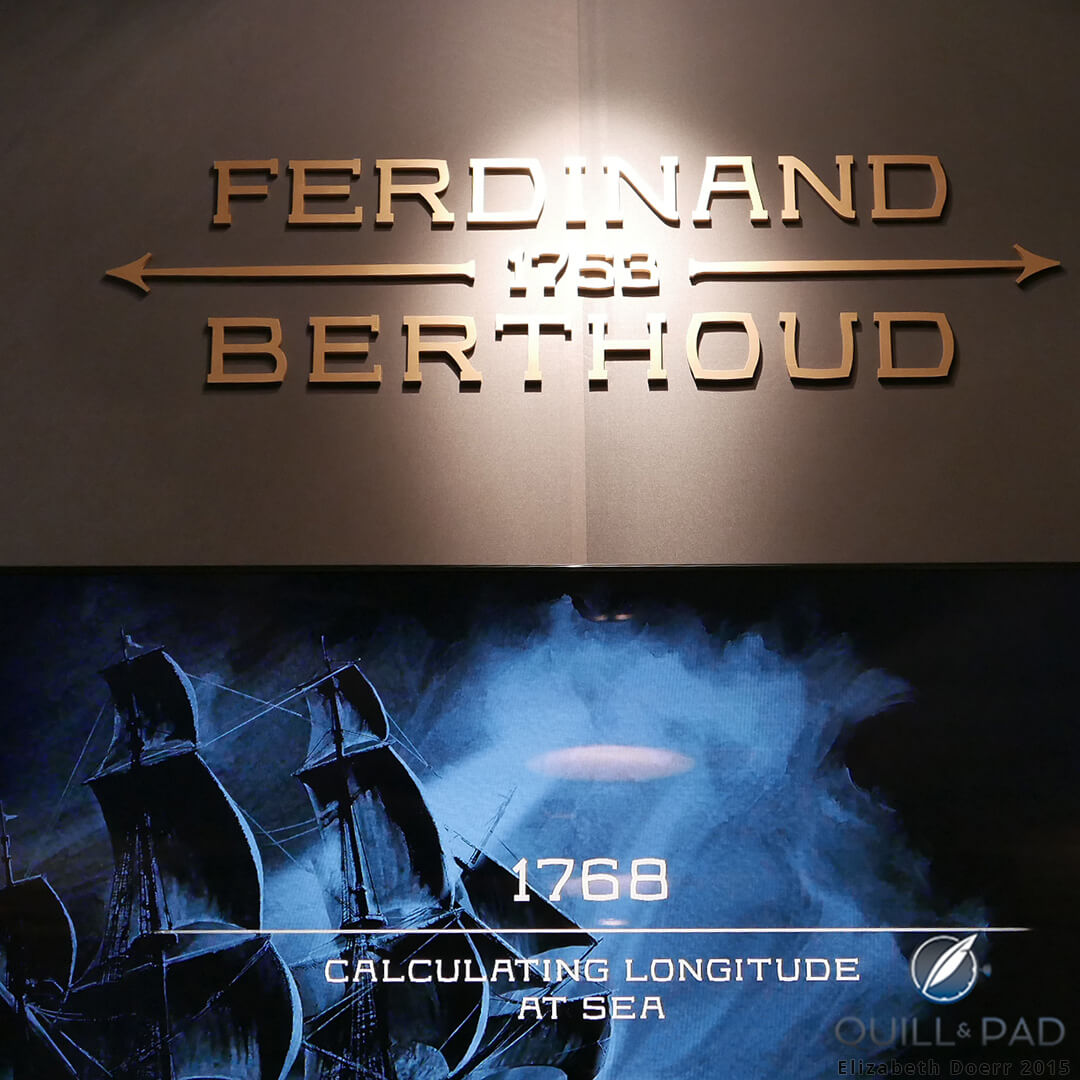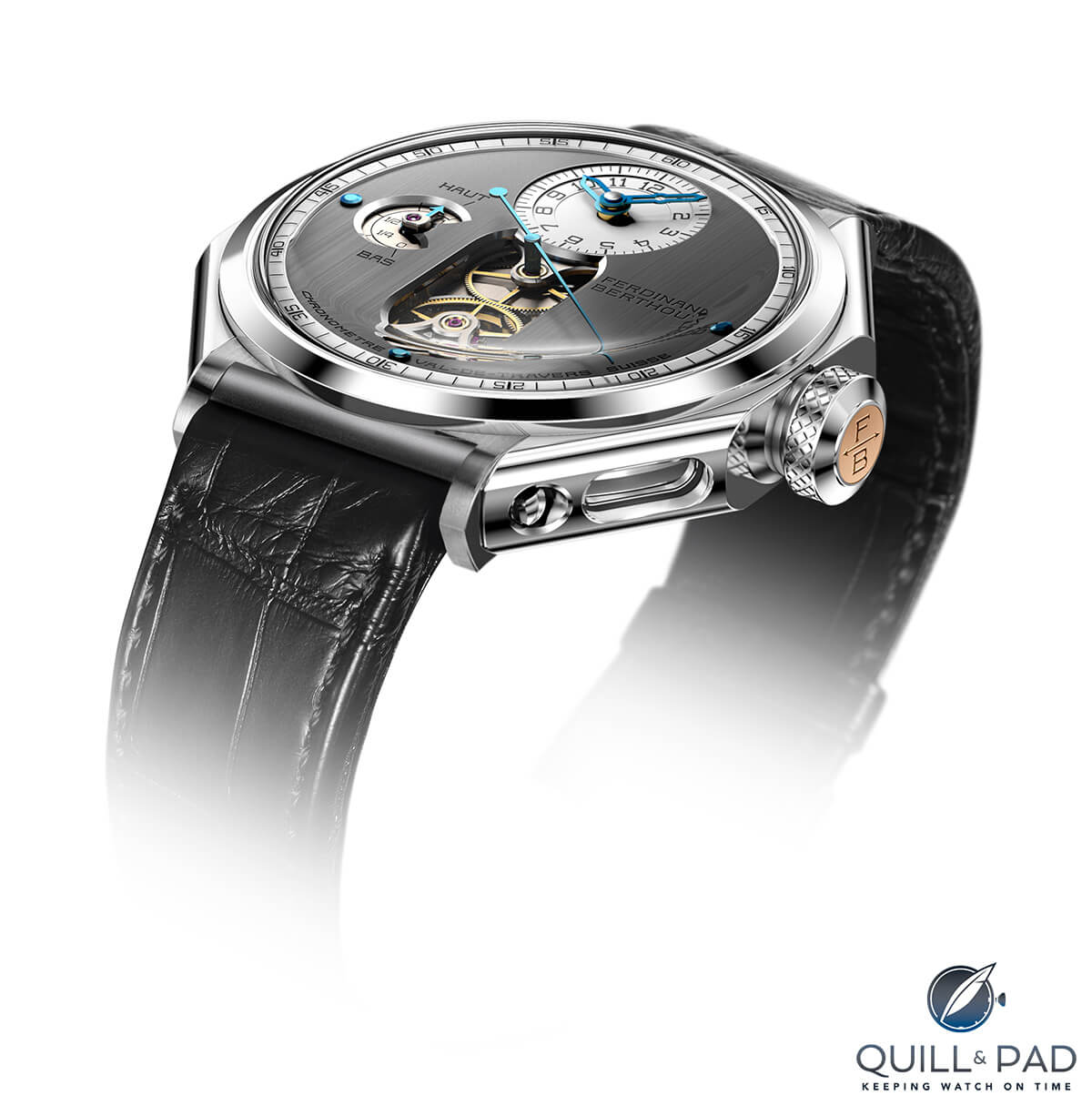You could see the excitement in Karl-Friedrich Scheufele’s eyes. The joy and pride were palpable, as was his desire to unveil the masterpiece he and his team had worked on for so long.
After eight long years it was finally time to reveal the mysterious timepiece that would emerge from the depths of the Chopard workshop under the aegis of Scheufele’s extensive passion for and knowledge of vintage timepieces.

It all started when the Scheufele family built a new factory in Fleurier now called Chopard Manufacture for the creation of the brand’s manufacture L.U.C. movements.
“I learned that Ferdinand Berthoud was born about five minutes away from Fleurier,” Scheufele remembered. “Not only did I become passionate about what he produced and what he wrote, but I found out quite by accident that somebody planned to relaunch ‘Berthoud watches’ in 2006. That year I was really too busy with everything else, but I still found it important to make sure that Berthoud is seen again, but in the way that I was feeling it should happen. So I negotiated the purchase of the rights to the name, and also the projects, which I had put away in my drawer.”
Scheufele continued, “For some time I really didn’t know what to do with Berthoud, but I knew that I didn’t want to do just any watch or any old development, it had to be something special. And basically, that is why we are here today . . . .”

Chopard co-president Karl-Friedrich Scheufele (left) and Ferdinand Berthoud’s head watchmaker Jean-Marc Beyerd
Team Berthoud
The new Ferdinand Berthoud watches are being built within Chopard Manufacture, but that doesn’t mean that the new brand – which is being handled like a very high-end boutique brand with limited production – is being created by Chopard’s employees. The fact is that Ferdinand Berthoud has a dedicated team of about five people right now.
These include general manager Vincent Lapaire, watchmaker Jean-Marc Beyerd, and communication and marketing specialist Audrey Humbert, who previously worked with Aurel Bacs at Christie’s.
To say that Ferdinand Berthoud’s team is passionate and knowledgeable would be a bit of an understatement. Take Humbert, for example. When word got around in Switzerland that Scheufele was getting ready to launch the new project, Humbert painstakingly crafted a letter directly to Scheufele to express her admiration. The entire team’s passion for the subject is obvious.
Contemporary translation
The first timepiece to emerge from this new constellation is called FB 1. It is intended as a natural continuation of the work accomplished by not only Ferdinand Berthoud, but also the two generations of Berthouds that followed him, which included his sons Pierre-Louis and Charles-Auguste Berthoud.
Scheufele as well as Lapaire often reiterated during the launch that they saw their goal as being to seek to transpose what progenitor Ferdinand Berthoud might have created had he continued to live to the modern day.
That is, of course, a tall order and one that very few reborn brands have managed to do with complete success. A. Lange & Söhne is one good example of such a goal being achieved.
Nonetheless, Caliber FB-T.FC has turned out to be everything that I could have hoped to see in a “reborn” and modernized Berthoud movement. Scheufele explains, “The contemporary translation of his genius consists in drawing inspiration from the master horologist’s most remarkable accomplishments in order to offer modern creations bearing reinterpreted distinctive features and evoking emblematic historical constructions.”
Scheufele knows that he has a real responsibility to be true to the historical watchmaker’s ideas in reviving his name for a new brand. However, German-born Scheufele’s declared goal is not to develop nostalgically commemorative timepieces but rather contemporary wristwatches worthy of bearing this name and deserving wrist time on the arms of the world’s leading connoisseurs.
“It has to be something special,” he said. “It’s a big responsibility to make the first Berthoud wristwatch meaningful and contemporary.”
Caliber FB-T.FC
Scheufele went on to explain that he and his team have taken risks to make this new timekeeper a contemporary one. “The watch should present all the technical elements of a timepiece from an eighteenth-century marine chronometer.”
The movement inside the new timepiece was chiefly inspired by Berthoud’s marine chronometer no. 6 from 1777, which is on display at Chopard’s L.U.CEUM in Fleurier. This particular marine chronometer is driven by a movement that includes a constant force chain-and-fusee system with a pillar-supported plate architecture. Precision was the foremost goal.
The freshly developed FB-T.FC movement, which needed three years of research and development, includes the same characteristics of the marine chronometer – which is simply astonishing since the new movement is a mere 8 mm in height.
First off we note the pillar-style movement architecture referencing eighteenth-century marine chronometers comprising German silver plates and bridges and polished titanium pillars. This style makes the entire construct look quite light and airy.
The three-Hertz movement outfitted with central seconds displayed by a 26-millimeter-long blued brass hand (brass was used rather than steel to ensure the right stiffness for this extra-long hand) also features constant force – in the form of a suspended chain-and-fusee transmission with differential-based winding system. The chain is 28 centimeters in length and comprises 474 wonderfully finished steel links and 316 pins that just barely measure 0.3 mm in diameter. It goes without saying that the chain is fully hand-assembled.

The tiny chain from the Ferdinand Berthoud FB1’s chain-and-fusée transmission laid out to show its length
The rotation of the spring barrel is what causes the chain to coil around the fusee (cone), which is equipped with an unusual differential gear to avoid any unforeseen stopping. The barrel is also controlled by a Maltese cross stopwork device, which limits the number of turns the barrel makes so as to use only the flattest part of the springs torque curve. This ensures more consistency of force whether the mainspring is near full or near empty.
The suspended mobile cone of the power reserve, whose display is shown at 9 o’clock on the dial, warranted a patent. Its design was inspired by a mechanism developed by the late George Daniels, a once-in-a-century English watchmaker. This mechanism directly links to the barrel by a wheel that utilizes the winding and unwinding motion of the spring barrel to make the small, truncated cone move up and down along an arbor attached to the base plate. A mobile arm topped off by a roller acts as a feeler spindle, measuring the motion of the cone and transmitting the information gleaned about the state of the remaining energy in the movement to the power reserve display’s hand.
The hand-wound movement boasts 53 hours of power reserve.
Tourbillon
This tourbillon-equipped regulator is outfitted with a variable inertia balance beating at a frequency of 3 Hz (21,600 vph). Scheufele described the origin of the balance spring as “in-house,” though he would not elaborate further on this. The balance wheel boasts two sets of inertia blocks.
Instead of creating a new escapement for the oeuvre, Lapaire and his team decided to use a standard Swiss lever escapement. “It was the best choice,” he said, continuing to explain that even Ferdinand Berthoud used this type of escapement many times in his own timepieces and even to regulate marine chronometers at times.
The tourbillon carriage comprising 67 components is unusual in that the single bridge holding it in place is secured using two 18-karat gold studs. The fourth wheel driving the seconds is placed coaxially to the carriage, enabling the central display of seconds. Ferdinand Berthoud’s engineers have filed a patent request for this construct.

A view of the Ferdinand Berthoud FB 1 revealing the portholes in the case band that provide visual access to the movement within
Reliability
Though FB 1 was not given over to the rigors of the Qualité Fleurier testing that Chopard supports (upon asking why, I was told that the QF testing is so rigorous that about five percent of a movement’s production is destroyed during the testing process), Caliber FB-T.FC easily passes the certification tests for both Chronofiable and the C.O.S.C. Indeed, what would an homage to a chronometer be without chronometer certification?
“And achieving this was very challenging,” Scheufele said.
This movement measuring 35.5 mm in diameter and 8 mm in height comprises more than 1,120 individual components (about 700 of which are found in the chain).
The look
The look of the Ferdinand Berthoud FB 1 was entirely dictated by Chopard’s experienced in-house designer Guy Bove, who went so far as to create a new, engineering-style typeface specifically for the watch. I feel that the typography provides the dial with a somewhat Chopard-like visual (though I am likely alone in this assertion).
“I imagined an eighteenth-century sports watch,” the designer born in the United States said as he introduced his reasoning for the various design elements.
Bove, who primarily used Berthoud’s Astronomical Clock III as his historical starting point, created an interesting case using dial asymmetry and octagonal elements as well as the lack of lugs to help keep the case size elegant, which was challenging given the sizable movement. In fact, despite the large movement, I found that the watch is very wearable, even on my small wrists.
Bove also explained that the octagonal case shape was inspired by the architecture of traditional marine chronometers and in particular the gimbal-suspension system typical of their wooden boxes.
I especially appreciate the inclusion of four lateral sapphire crystal “portholes” in the case sides, which allow a view of the chain-and-fusee subassembly at work. This element was directly taken from eighteenth-century marine chronometers, which contained such portholes to provide a view of the movement so that people could directly see if they were running or not.
The sapphire crystal display back allows a full view of the very aesthetic, finely finished movement.
Unlike eighteenth-century marine chronometers, the case of the FB 1 is water-resistant to 30 m. “The entire thing looks more like an artifact than a watch,” Bove joked as he explained the reasoning for the “thumb-screw” style of the crown topped off with what looks like a seal.
The Ferdinand Berthoud team plans to make first deliveries in December 2015, estimating to be able to make three or four watches per month. Further timepieces are already in the pipeline, including more complicated pieces and a less complicated watch that is likely to retail for around €50,000.
Quick Facts
Case: 44 x 13 mm, pink gold or white gold, no lugs
Movement: hand-wound Caliber FB-T.FC with chain-and-fusée constant force system, one-minute tourbillon, and pillar-style architecture, 3 Hz frequency and 53 hours power reserve, C.O.S.C. certification
Functions: hours, minutes, central seconds; power reserve display
Limitation: 50 pieces in each case metal
Price: €220,000
*This article was first published on Quill & Pad on September 23, 2015 at Ferdinand Berthoud Is Reborn With FB 1 Thanks To Chopard’s Karl-Friedrich Scheufele.
































































Leave a Reply
Want to join the discussion?Feel free to contribute!